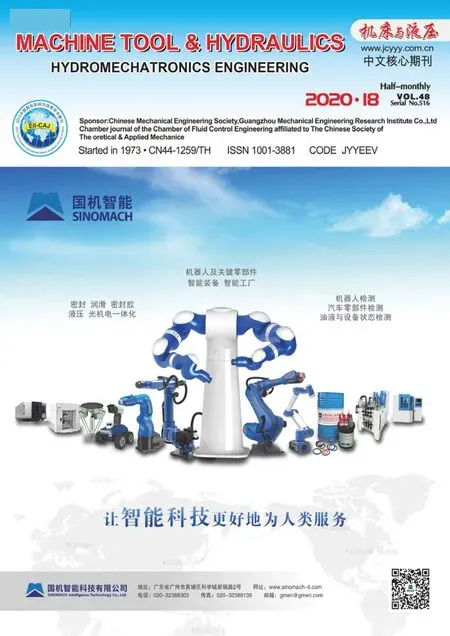Research on the thigh injury of a frontal collision dummy based on a certain type of vehicle
Qing-yong ZENG,Zhong-ke XIANG,Wen-ming CHENG,3,Hao-ran CHEN
(1 Jiangxi Agricultural University,Nanchang 330045,China)
(2 Jiangxi University of Technology,Nanchang 330045,China)
(3 Collaborative Innovation Center of Automobile Service Engineering and Industrial Upgrading,Jiangxi University of Technology,Nanchang 330045,China)
Abstract:The comprehensive evaluationmethod of thigh is proposed.The simulationmodel of the car frontal collision occupant restraint system is established by MADYMO simulation software.The reliability of the model is verified by experiments,and the thigh injury curve is benchmarked.In the above,the thigh injury was studied from the IP position,the angle of the occupant’s lower limb offset,and the angle between the lower leg and the floor.The results show that:ergonomics,while the IP position is located in the occupant’s knee,the team members have the least impact;the occupant’s lower limb bias angle is12°.For the best position;reducing the angle between the calf and the floor can reduce the damage of the occupant’s thigh to varying degrees.Therefore,when the car collides,adjusting the relevant parameter parameters in advance can effectively reduce the risk of occupant injury,which is of great significance for the research and development of the car’s active safety.
Key words:Thigh injury,Madymo,Lower limb collision position,Lower limb offset angle,Angle between calf and floor
1 Introduction
With the continuous improvement of China’s scientific and technological level,in the field of automobile safety,active and passive safety are the top priorities of safety research and development personnel,and the technological level hasmade great progress and development.At the same time,safety technology ismore extensive One of the main reference factors for consumers to choose a car.However,in the research and development of safety technology,people usually pay attention to the head and chest injury research of the occupants in the car.In contrast,the research on the occupant’s leg injury is relatively limited,let alone the studyon the thigh injury.In traffic accidents,thigh injuries are one of themain reasons for the disability of the lower limbs of the occupants.They are serious and may be life-threatening.Therefore,how to reduce thigh injuries during the accident become an urgent task.
At present,many scholars have also analyzed and studied the injury characteristics and impact of thighs in accidents.In 2015,LIUZhenhai et al[1]used Knee mapping finite element method for simulation and optimization of hard points that may cause thigh injury.The results show that sufficient deformation space is reserved through the internal structure of the instrument panel,and the shield is under the combination switch.Internally,the collapse energy absorption structure is designed to effectively reduce the thigh injury value.In 2011,FENGHuyin[2]summarized the injurymechanism of the thigh area of the occupant in a frontal collision and the injury criteria of the occupant’s thigh and knee injury.The design method optimizes the thigh injury indicators of passengers who violate the regulations,and obtain the optimal restraint system parameters and instrument panel stiffness.In 2012,LIU Zhenhai[3]proposed to guarantee the dummy’s lower limbs and instrument panel in the event of collision.The first point of contact is the IP profile design of the dummy’s knee.In addition,GERuhai[4]and others established a finite elementmodel of the front end of a vehiclemodel for pedestrian protection research,and adopted measures to weaken the stiffness of the headlights of vehicles.The test results show that the protection of pedestrian thighs can be improved.Performance,however,this is already a collision between a person and a car.The collision occurred outside the car,and the thigh injury to the occupant inside the car is still quite small.Based on the actual vehicle data of a certain model,this article tries to establish a simulation model of the vehicle frontal impact occupant restraint system for thigh injury research with MADYMO software.The impacts are from three aspects:IP position,occupant lower limb offset angle,and the angle between the lower leg and the floor.
2 Evaluation indicators and dam age level judgm ent
2.1 Thigh injurymechanism and evaluation index
Thigh injury is one of the most common injuries in car accidents.The degree of injury ismainly evaluated by the two physical quantities of knee sliding displacement and thigh compression force.It is one of themain causes of disability of the lower limbs of the occupants and the risk of lifelong disability can be life-threatening.The schematic diagram of the occupant’s knee stress is shown in Fig.1 below.

Fig.1 Schem atic diagram of the occupant’s knee force
In C-NCAP and E-NCAP,thigh injury evaluation indicators include thigh compression force and knee sliding displacement,both of which have their high and low performance indicators.Specific performance indicators are shown in Table 1 below.
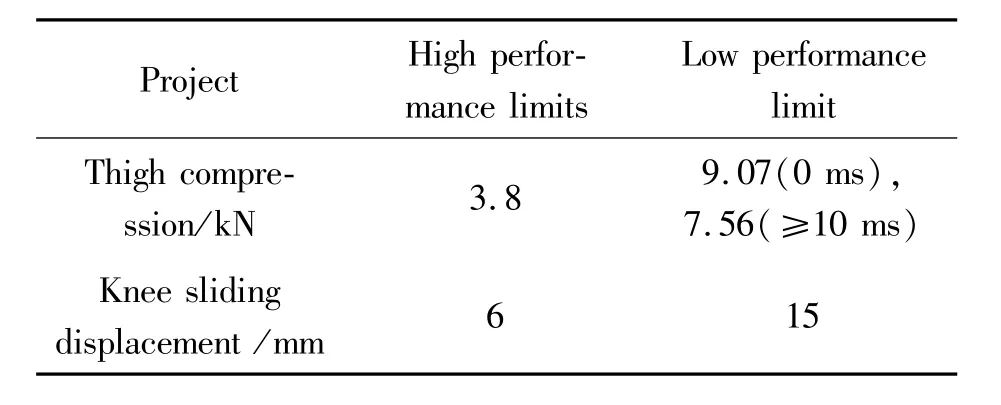
Tab Ie 1 C-NCAP and E-NCAP dumm y thigh perfo rmance indicators[5]
2.2 Dynamic Modelling of active suspension with dead zone input
Because there aremultiple evaluation indicators for the thigh,there is a coupling effectbetween the evaluation indicators,and it cannot be evaluated by referring to a single indicator.Therefore,this article proposes amore intuitive discrimination method that can take into account the interaction between various factors to determine the injury level of the thigh.There are twomain evaluation indexes of thighs:thigh compression force and knee sliding displacement.These two parameters are equally important for thigh injury evaluation,so each of them is taken(thigh compression forceF,knee sliding displacementL).The injury indices are added to obtain the total injury indexTH.The calculation formula is:

Among them,FLandFRare left and right thigh forces;LLandLRare left and right knee compression amounts.
According to the value ofTHand the degree of damage to the thigh,the injury level is determined in Table 2.
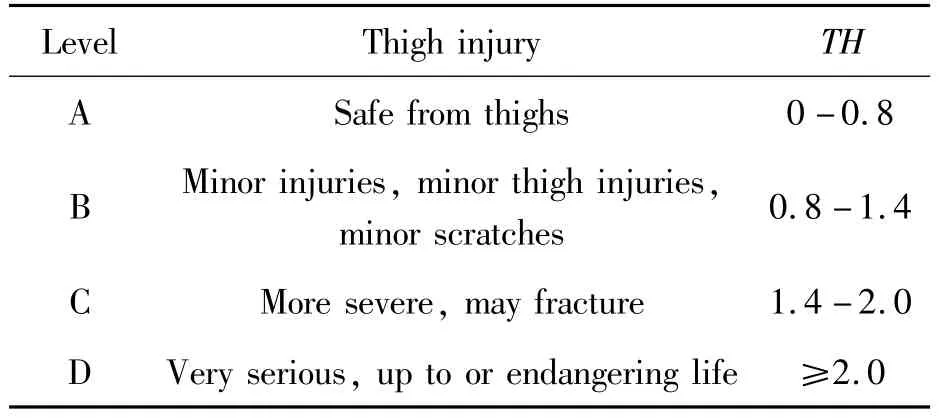
Tab Ie 2 Damage Ieve Icom parison tab Ie
The higher the level of injury is,the more serious the thigh injury is,the greater theTHvalue is,the higher the thigh injury is.In thisway,only aTHvalue is needed to judge the thigh injury,which ismore intuitive and clear from the data.
3 Estab lishm ent and verification of simu lation m odels
In order to study the relationship between the two main indexes of thigh injury evaluation,thigh compression force and knee sliding displacement,and the mechanism.Based on the dimensions and performance parameters of the passenger compartment of a certain vehiclemodel,the finite elementmodel is shown in Fig.2.

Fig.2 Car body finite e Iem entmode I
MADYMO simulation software is used to establish a simulation model of the vehicle frontal impact passenger restraint system,and then the entire test process is analyzed.This model includes the Hy-brid IIImale 50th percentile dummy model,airbags,seat belts,and a built-in occupant indoor environmentmodel included in the MADYMO simulation software.The established model is based on the actual vehicle conditions.Corresponding parameters,contact characteristics and corresponding stiffness characteristics are set to simulate the driver’s frontal collision model.The simulationmodel of the vehicle frontal impact passenger restraint system is shown in Fig.3 below.

Fig.3 Sim u Iation m ode Iof the fron ta Ico IIision d river’s side restraint system
Through the analysis of the results of a large number of tests,although the frequency of head and chest injuries can be the highest,the frequency of thigh injuries cannot be ignored.Themain factors affecting the safety factor include the seat belt force limit level,the angle between the legs of the dummy,and the car seat.The position of the chair,the seat beltmodel,and the impact position of the occupant’s legs and dashboard during a collision.In order to study the reliability of the model,simulation and test data are mainly used to verify the occupants’shoulder belt force,waist belt force,pelvic acceleration,and axial force on the left and right thighs.Fig.4 below shows the comparison between the simulation model of the frontal collision and the dynamic response of the dummy in the crash test.
From Fig.4,it can be clearly observed that in the benchmarking test,except for the belt force and the right thigh force,the effect on the watch is not excellent,and the test and simulation results of other parts are better on the watch.This is because the dummy moves forward toofast,the belt strength is greater,and the dummy’s legs come in contact with the knee flaps earlier[8].However,the time and trend of each evaluation index including the belt force and the right thigh force are quite consistent.Within the control range of the error,it shows that the reliability is high,so it can be studied in the future.
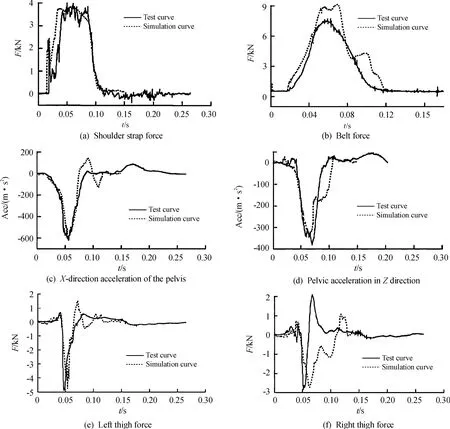
Fig.4 Simu Iation and test benchmark curve
4 Thigh in jury analysis
This article analyzes thigh injury from three aspects:IP(Impact point)position,occupant lower limb offset angle,and the angle between the lower leg and the floor.
4.1 Impact of IP(impact point)position on thigh injury
During a car collision,the occupant willmove forward due to the effectof inertia,so that the occupant’s lower limbs will collide with the instrument panel.The first contact point between the occupant’s lower limbs and the instrument panel,that is,the impact position is called IP(Impact point).Fig.5 below shows the force diagram of the occupant’s lower limbs.
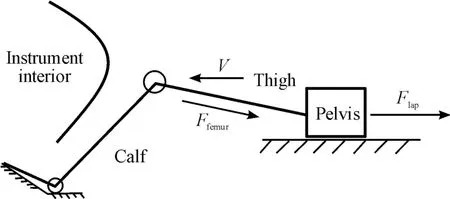
Fig.5 Force diagram of the Iower Iimbs of the occupant
IP is often not the ideal point during a collision.On the established frontal collision model of the car,the seat belt is worn normally and the airbag is normal.The rigid connection between the seat,the floor,and the instrument panel is set.According to the different IP tests,The IP location is shown in Fig.6 below.After setting various parameters.Table 3 below shows the results obtained by the tests.
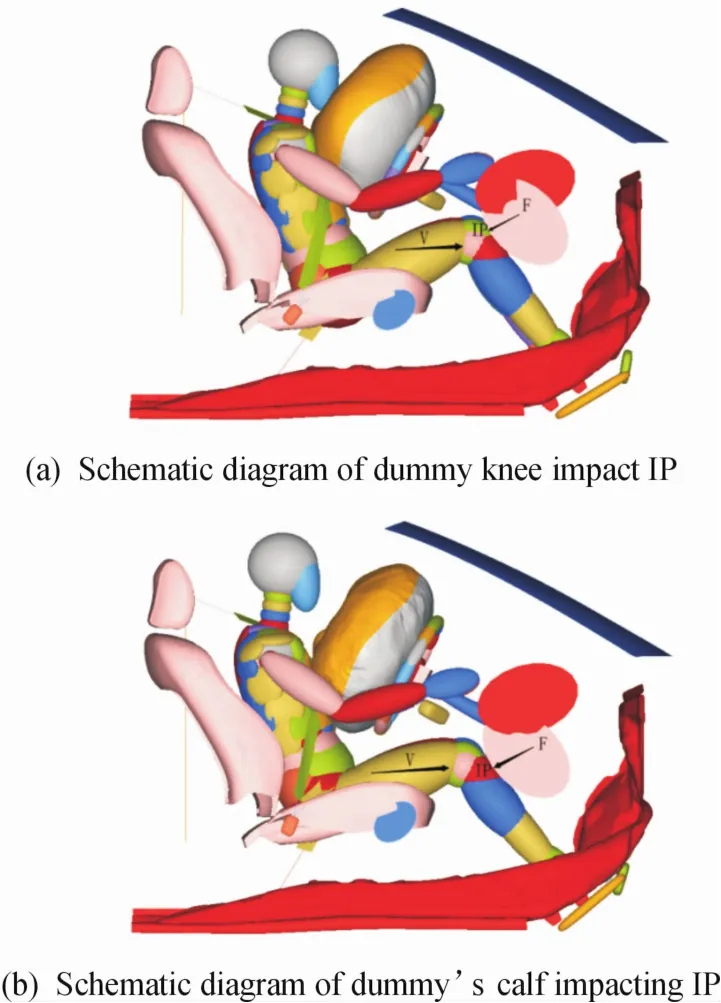
Fig.6 Dumm y im pac t Iocation IP schem atic
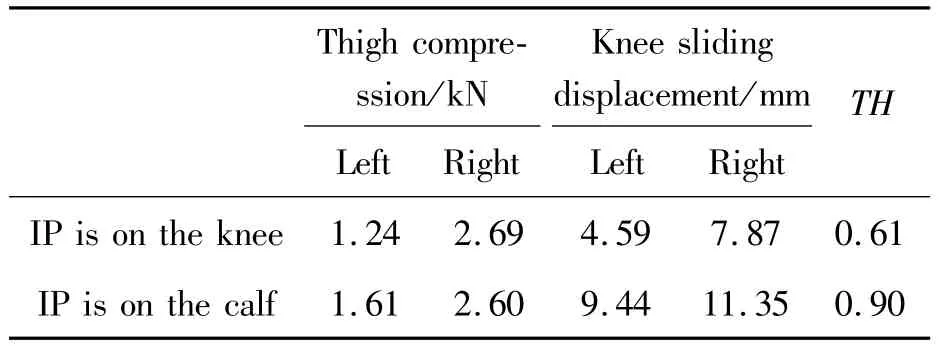
Tab Ie 3 Study on thigh in jury at different IP Iocations
As can be seen from Table 3,when the IP is located on the knee,its TH value is significantly lower than the value which based on the condition that IP is located on the lower leg position.The lower theTHvalue,the lower the thigh injury.With reference to Table 2,the corresponding damage levels are A and B,respectively.
4.2 Impact of occupant lower limb offset angle on thigh injury
A large number of studies have shown that the deformation of the vehicle body caused a small backward movement of the center console to crush the leg along the direction of the femur is the main cause of occupant thigh injury.The occupant’s lower limbs have a certain offset angle,which can greatly reduce the damage to the occupant’s thigh.
Fig.7 shows the definition of the occupant’s lower limb offset angle.The occupant’s lower limbs turned in a vertical direction and turned in opposite directions with their feet together.Generally,the occupants’calf and feetwill hit the floor or the car body and the flexibility of the human body is limited,so the rotation angle cannot be toowide.Based on the actual vehicle data of a certain vehicle,the maximum value of the rotation angleαis determined to be 15°.

Fig.7 Definition of occupant Iower Iimb offset ang Ieα
As can be seen from Table 4,when the offset angle is 15,theTHvalue become the lowest,the corresponding injury level is A which meets the high-performance index of thigh injury evaluation,and the protection of the occupants is themost obvious.
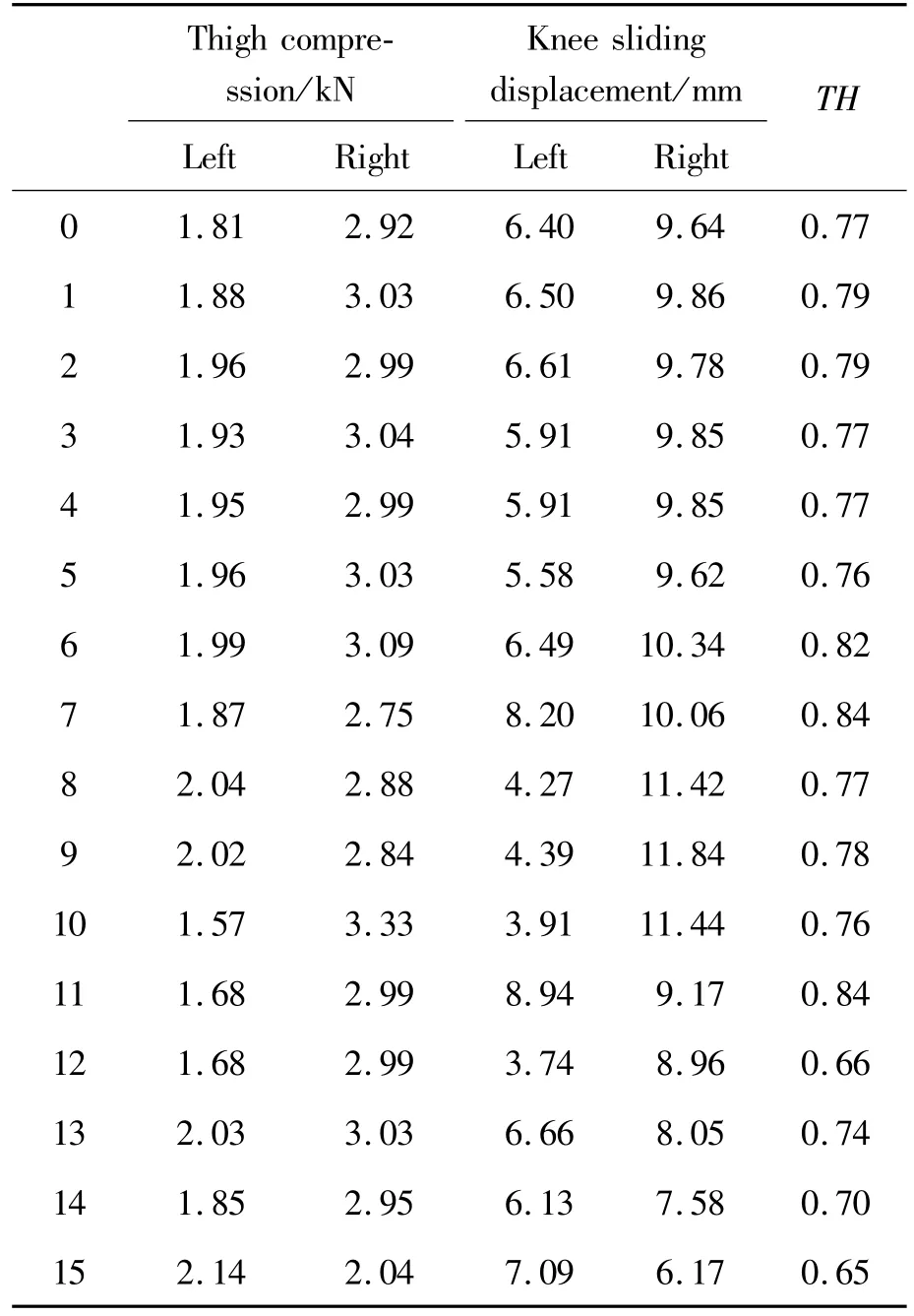
Tab Ie 4 Com parison of resu Its of different offset ang Ies for thigh in jury
In consideration of ergonomics,the offset angle is too large on this condition,and the occupant’s leg may be collided with the door ifits opening angle is too largein accident.Similarly,Table 4 shows that it is betterwhen the offset angle is 12°.Therefore,when a car collides,restrain the occupants’lower limbs to a certain angle in advance,which has a good protection effect on the occupants.
4.3 Injury effect of dummy thigh and ground thigh
In the crash test,the thigh injurymainly came from the thigh compression force and the knee sliding amountwhen the dummy’s knee and calf hit the dashboard[6].Studies have shown that the angleβbetween the centerline of the calf and the ground when the dashboard contacts the dummy during a crash test has a significant effect on the thigh force and knee displacement of the occupant.Fig.8 below defines the angleβbetween the calf centerline and the ground.

Fig.8 Ang Ie between the cen terIine of the ca If and the groundβDefinition
With reference to the actual vehicle data and ergonomics of a certain vehicle,the included angleβ should have an appropriate range.Excessive damage will not only increase the damage,but also cause discomfort to the driver or occupants.Therefore,the beta test range in this paper is50°-85°Between to 5°A total of8 testswere performed for the step adjustmentβ.The simulation results are shown in Table 5 below.
As can be seen from Table 5,as the angleβbetween the centerline of the lower leg and the ground continues to decrease,the sliding displacement of the knee increases,theTHvalue continues to increase,and the corresponding damage level is gradually upgraded,which has a greater impact on the thigh.
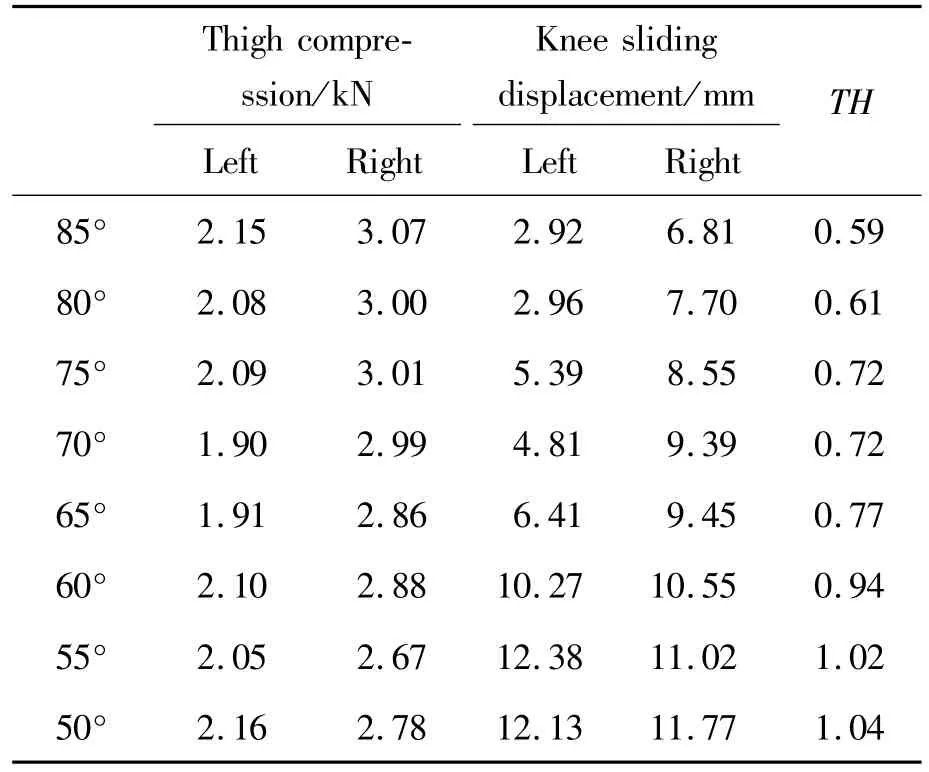
Tab Ie 5 Study on thigh in jury by different IP positions
5 Conclusion
A simulation model of the frontal collision restraint system of a certain vehicle model was established by using the MADYMO engineering software,and then the reliability of the established simulation model was verified,and the IP(Impact point)position,the occupant lower limb offset angle,and the angle between the lower leg and the floor.Therefore,the research on occupant thigh injuries has drawn the following conclusions:
(1)Established a new thigh injury evaluation strategy and grade evaluation.The main evaluation indexes of thigh compression force and knee sliding displacementwere integrated into the thigh overall evaluation injury valueTHand level.The degree of thigh injury can be determined through.
(2)Different IP positions have different impacts on occupant thighs.When the IP position is on the knees,it has the lowest impact on occupant thighs.
(3)Conforming to ergonomics,the impact on thigh injuries can be minimizedwhen the occupant’s lower limb offset angle is 12.
(4)The smaller the angleβbetween the centerline of the calf and the ground,the smaller the impact on injury.
(5)For the study of thigh injuries,the results obtained in this article can fully prove that restraining the occupants to the best state in advance can greatly reduce the injuries to the thighs of the passengers during a collision.
- 机床与液压的其它文章
- Decoupling control of single DOF supporting system ofmagnetic-liquid double suspension bearing
- Influence of the thermal effect on the sealing performance of the hydraulic combined dynam ic seal
- Dynam ic GRNNmodel of hydraulic system fault detection based on the internet of things technology
- Form ing modeling and sensitivity analysis of sandwich composites
- Research of aerodynam ic characteristics of heavy commercial vehicles under crosswind for different urban road layout
- Design ofmulti-parameter ultrasonic measuring instrument for fluid

